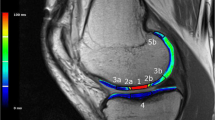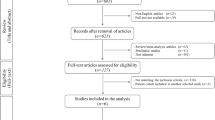Abstract
Purpose
The influence of gender on the biomechanical outcome after autologous chondrocyte implantation (ACI) including isokinetic muscle strength measurements has not been investigated. The present prospective study was performed to evaluate gender-specific differences in the biomechanical function 48 months after ACI.
Methods
Fifty-two patients (mean age 35.6 ± 8.5 years) that met our inclusion criteria, underwent ACI with Bioseed C® and were evaluated with the KOOS score preoperatively, 6, 12 and 48 months after surgery. At final follow-up, 44 out of the 52 patients underwent biomechanical evaluation with isokinetic strength measurements of both knees. All data were evaluated separately for men and women and compared for each time interval using the Mann–Whitney U test.
Results
Clinical scores improved significantly over the whole study period (p < 0.05). Male patients demonstrated significantly better scores during the follow-up in the KOOS score (p < 0.05). Isokinetic strength measurements after 48 months revealed a significant strength deficit of the treated knee in all test modes compared to the healthy extremity (p < 0.05). Furthermore, male patients achieved significantly higher strength values compared to female patients (p < 0.05).
Conclusions
ACI is a viable treatment option for full-thickness chondral defects in the knee of both genders. Isokinetic muscle strength measures are significantly worse in women (p < 0.05), but physiological and may play a role for the explanation of gender-specific results after ACI.
Level of evidence
II.

Similar content being viewed by others
References
Aglietti A, Gambardella R, Hangody L et al (2000) http://www.cartilage.org/_files/contentmanagement/ICRS_evaluation.pdf
Brittberg M, Lindahl A, Nilsson A, Ohlsson C, Isaksson O, Peterson L (1994) Treatment of deep cartilage defects in the knee with autologous chondrocyte transplantation. N Engl J Med 331(14):889–895
Brun P, Dickinson SC, Zavan B, Cortivo R, Hollander AP, Abatangelo G (2008) Characteristics of repair tissue in second-look and third-look biopsies from patients treated with engineered cartilage: relationship to symptomatology and time after implantation. Arthrits Res Ther 10(6):R132
Della Villa S, Kon E, Filardo G, Ricci M, Vincentelli F, Delcogliano M, Marcacci M (2010) Does intensive rehabilitation permit early return to sport without compromising the clinical outcome after arthroscopic autologous chondrocyte implantation in highly competitive athletes? Am J Sports Med 38(1):68–77
Dunkel L (2006) Use of aromatase inhibitors to increase final height. Mol Cell Endocrinol 25:207–216
Erggelet C, Kreuz PC, Mrosek EH, Schagemann JC, Lahm A, Ducommun PP, Ossendorf C (2010) Autologous chondrocyte implantation versus ACI using 3D-bioresorbable graft for the treatment of large full-thickness cartilage lesions in the knee. Arch Orthop Trauma Surg 130(8):957–964
Gikas PD, Morris T, Carrington R, Skinner J, Bentley G, Briggs T (2009) A correlation between the timing of biopsy after autologous chondrocyte implantation and the histological appearance. J Bone Joint Surg 91-B:1172–1177
Goldring MB, Goldring SR (2007) J Cell Physiol. Osteoarthritis 213(3):626–634
Granata KP, Padua DA, Wilson SE (2002) Gender differences in active musculoskeletal stiffness. Part II. Quantification of leg stiffness during functional hopping tasks. J Electromoyogr Kinesiol 12(2):127–135
Griffin LY, Albohm MJ, Arendt EA et al (2006) Understanding and preventing noncontact anterior cruciate ligament injuries: a review of the Hunt valley II meeting, January 2005. Am J Sports Med 34(9):1512–1532
Gudas R, Kalesinskas RJ, Kimtys V, Stankevicius E, Toliusis V, Bernotavicius G, Smailys A (2005) A prospective randomized clinical study of mosaic osteochondral autologous transplantation versus microfracture for the treatment of osteochondral defects in the knee joint in young athletes. Arthroscopy 21(9):1066–1075
Harmon KG, Ireland ML (2000) Gender differences in noncontact anterior cruciate ligament injuries. Clin Sports Med 19:287–302
Hewett TE, Myer GD, Ford KR, Heidt RS Jr, Colosimo AJ, McLean SG, van den Bogert AJ, Paterno MV, Succop P (2005) Biomechanical measures of neuromuscular control and valgus loading of the knee predict anterior cruciate ligament injury risk in female athletes: a prospective study. Am J Sports Med 33:492–501
Hunziker EB (2002) Articular cartilage repair: basic science and clinical progress. A review of the current status and prospects. Osteoarthritis Cartilage 10:432–463
Jenei-Lanzl Z, Straub RH, Dienstknecht T, Huber M, Hager M, Grässel S, Kujat R, Angele MK, Nerlich M, Angele P (2010) Estradiol inhibits chondrogenic differentiation of mesenchymal stem cells via nonclassic signaling. Arthritis Rheum 62(4):1088–1096
Jungmann PM, Salzmann GM, Schmal H, Pestka JM, Südkamp NP, Niemeyer P (2012) Autologous chondrocyte implantation for treatment of cartilage defects of the knee: what predicts the need for reintervention? Am J Sports Med 40(1):58–67
Karimian E, Sävendahl L (2011) Estrogen signaling in growth plate cartilage. Endocr Dev 21:42–51
Knutsen G, Drogset JO, Engebretsen L, Grontvedt T, Isaksen V, Ludvigsen TC, Roberts S, Solheim E, Strand T, Johansen O (2007) A randomized trial comparing autologous chondrocyte implantation with microfracture. Findings at five years. J Bone Joint Surg Am 89(10):2105–2112
Kon E, Filardo G, Berruto M, Benazzo F, Zanon G, Della Villa S, Marcacci M (2011) Articular cartilage treatment in high-level male soccer players: a prospective comparative study of arthroscopic second-generation autologous chondrocyte implantation versus microfracture. Am J Sports Med 39(12):2549–2557
Kreuz PC, Erggelet C, Steinwachs MR, Krause SJ, Lahm A, Niemeyer P, Ghanem N, Uhl M, Südkamp N (2006) Is microfracture of chondral defects in the knee associated with different results in patients aged 40 years or younger? Arthroscopy 22(11):1180–1186
Kreuz PC, Müller S, Freymann U, Erggelet C, Niemeyer P, Kaps C, Hirschmüller A (2011) Repair of focal cartilage defects with scaffold-assisted autologous chondrocyte grafts: clinical and biomechanical results 48 months after transplantation. Am J Sports Med 39(8):1697–1705
Kreuz PC, Steinwachs M, Erggelet C, Krause SJ, Ossendorf C, Maier D, Ghanem N, Uhl M, Haag M (2007) Classification of graft hypertrophy after autologous chondrocyte implantation of full-thickness chondral defects in the knee. Osteoarthritis Cartilage 15(12):1339–1347
Kreuz PC, Steinwachs M, Erggelet C, Lahm A, Krause S, Ossendorf C, Meier D, Ghanem N, Uhl M (2007) Importance of sports in cartilage regeneration after autologous chondrocyte implantation: a prospective study with a 3-year follow-up. Am J Sports Med 35(8):1261–1268
Loken S, Ludvigsen T, Hoysveen T, Holm I, Engebretsen L, Reinholt FP (2009) Autologous chondrocyte implantation to repair knee cartilage injury: ultrastructural evaluation at 2 years and long-term follow-up including muscle strength measurements. Knee Surg Sports Traumatol Arthrosc 17:1278–1288
Mandelbaum BR, Silvers HJ, Watanabe DS, Knarr JF, Thomas SD, Griffin LY, Kirkendall DT, Garrett W (2005) Effectiveness of a neuromuscular and proprioceptive training program in preventing anterior cruciate ligament injuries in female athletes: 2-year follow-up. Am J Sports Med 33(7):1003–1010
Miller AEJ, MacDougall JD, Tarnopolsky MA, Sale DG (1993) Gender differences in strength and muscle fiber characteristics. Eur J Appl Physiol 66:254–262
Peterson L, Brittberg M, Kiviranta I, Akerlund EL, Lindahl A (2002) Autologous chondrocyte transplantation: biomechanics and long-term durability. Am J Sports Med 30(1):2–12
Peterson L, Vasiliadis HS, Brittberg M, Lindahl A (2010) Autologous chondrocyte implantation: a long-term follow-up. Am J Sports Med 38(6):1117–1124
Roos EM, Roos HP, Lohmander LS, Ekdahl C, Beynnon BD (1998) Knee Injury and Osteoarthritis Outcome Score (KOOS)-development of a self-administered outcome measure. J Orthop Sports Phys Ther 28(2):411–418
Saris D, Vanlauwe J, Victor J, Almqvist KF, Verdonk R, Bellemans J, Luyten FP, TIG/ACT/01/2000&EXT study group (2009) Treatment of symptomatic cartilage defects of the knee: characterized chondrocyte implantation results in better clinical outcome at 36 months in a randomized trial compared to microfracture. Am J Sports Med 37(Suppl 1):10S–19S
Schinhan M, Gruber M, Vavken P, Dorotka R, Samouh L, Chiari C, Gruebl-Barabas R, Nehrer S (2012) Critical-size defect induces unicompartmental osteoarthritis in a stable ovine knee. J Orthop Res 30(2):214–220
Schneider U, Rackwitz L, Andereya S, Siebenlist S, Fensky F, Reichert J, Läer I, Barthel T, Rudert M, Nöth U (2011) A prospective multicenter study on the outcome of type I collagen hydrogel-based autologous chondrocyte implantation (CaReS) for the repair of articular cartilage defects in the knee. Am J Sports Med 39(12):2558–2565
Schroeppel JP, Crist JD, Anderson HC, Wang J (2011) Molecular regulation of articular chondrocyte function and its significance in osteoarthritis. Histol Histopathol 26(3):377–394
Semmler JG, Kutzscher DV, Enoka RM (1999) Gender differences in the fatigability of human skeletal muscle. J Neurophysiol 82:3590–3593
Steadman JR, Briggs KK, Rodrigo JJ, Kocher MS, Gill TJ, Rodkey WG (2003) Outcomes of microfracture for traumatic chondral defects of the knee: average 11-year follow-up. Arthroscopy 19:477–484
Steinwachs M, Kreuz PC (2007) Autologous chondrocyte implantation in chondral defects of the knee with a type I/III collagen membrane: a prospective study with a 3-year follow-up. Arthroscopy 23(4):381–387
Vanlauwe J, Saris DB, Victor J, Almqvist KF, Bellemans J, Luyten FP, TIG/ACT/01/2000&EXT study group (2011) Five-year outcome of characterized chondrocyte implantation versus microfracture for symptomatic cartilage defects of the knee: early treatment matters. Am J Sports Med 39(12):2566–2574
Victor J, Labey L, Wong P, Innocenti B, Bellemans J (2010) The influence of muscle load on tibiofemoral knee kinematics. J Orthop Res 28(4):419–428
Wojtys EM, Huston LJ, Schock HJ, Boylan JP, Ashton-Miller JA (2003) Gender differences in muscular protection of the knee in torsion in size-matched athletes. J Bone Joint Surg 85(5):782–789
Zhong M, Carney DH, Boyan BD, Schwartz Z (2011) 17ß-estradiol regulates rat growth plate chondrocyte apoptosis through a mitochondrial pathway not involving nitric oxide or MAPKs. Endocrinology 152(1):82–92
Acknowledgments
No financial support of this project has occurred. The authors have received nothing of value. This manuscript does not contain information about medical devices.
Author information
Authors and Affiliations
Corresponding author
Additional information
Peter C. Kreuz and Sebastian Müller contributed equally to the work.
Rights and permissions
About this article
Cite this article
Kreuz, P.C., Müller, S., Erggelet, C. et al. Is gender influencing the biomechanical results after autologous chondrocyte implantation?. Knee Surg Sports Traumatol Arthrosc 22, 72–79 (2014). https://doi.org/10.1007/s00167-012-2280-3
Received:
Accepted:
Published:
Issue Date:
DOI: https://doi.org/10.1007/s00167-012-2280-3




